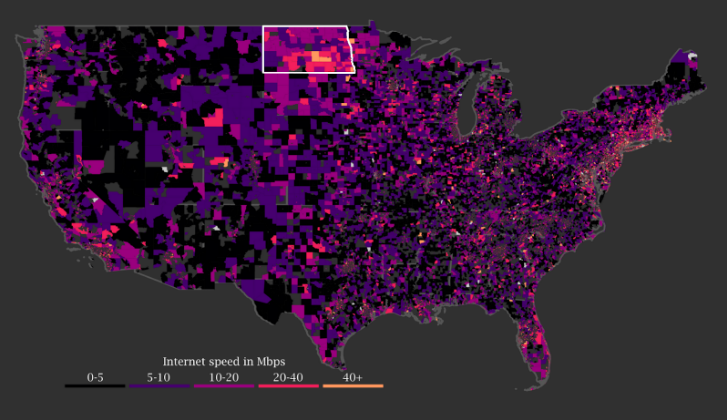For inhabitants of urban areas, Internet access feels like a guarantee. However, rural residents know that having access to reliable Internet is anything but certain.
To bridge that connectivity gap and help expand the reach of broadband service to rural areas, the Affordable Connectivity Program was created in late 2021.
But what kind of infrastructure is available to rural communities looking to expand access to all residents? Multiple types of infrastructure can create broadband connectivity, each with unique benefits and drawbacks. In all cases, cost is a driving consideration.
No singular solution will work to equip all rural areas with high-speed broadband because every area has a unique baseline of resources available and different considerations when selecting broadband infrastructure that works for their region.
This post breaks down five kinds of Internet infrastructure and where rural communities might best utilize it.
Five Types of Broadband Infrastructure
Broadband infrastructure refers to the networks of deployed telecommunications equipment and technologies necessary to provide high-speed Internet access.

The most commonly used broadband infrastructures include plain old telephone services, fiber-optic cables, satellites, 4G and 5G networks, and fixed-wireless networks.
Let’s look at each in detail, including the benefits and drawbacks.
1. Plain Old Telephone Service (POTS)
Plain Old Telephone Service is the traditional analog phone service operating through physical copper wires.
These are the old-school telephone poles and wires draped along roadsides and over hills, connecting individual homes to communication networks.
The benefits of upgrading the POTS system are clear:
Copper wires in good condition can be enhanced with the addition of a modem (a digital device that converts phone data into a data format that’s transmissible through the POTS), yielding high-speed internet connectivity.
Established telephone lines in rural areas are commonplace, which makes them an excellent resource for expanding high-speed internet to rural areas. Modems in the home physically connect a computer to the Internet through a cable and provide fast and stable connections.
The list of drawbacks, however, is not insignificant:
Signal interference often comes from inclement weather; because the infrastructure is out in the open, damage to the poles and wires will interrupt services.
Attenuation (the loss of signal over distance) occurs as a user is further from robust POTS infrastructure.
Users also experience asymmetrical speeds for uploading and downloading.

2. Fiber-Optic Cables
Unlike the copper cables in POTS systems which use electrical voltage to transmit data, fiber-optic cables are broadband-specific cables buried underground that create a communicating network of glass or plastic carrying light (data).
This revolutionary invention provides a fast and reliable internet connection, and because the cables are buried, the quality of the connection is not impacted by weather and is infrequently damaged.
Certainly, drawbacks exist:
It is a labor-intensive resource to deploy (and not cheap)!
For example, the cost for providers to install fiber-optic calves is between $1 and $6 per linear foot of cable. However, this does not include labor and machinery, conduit, and any unforeseen setbacks a large installation might face.
Furthermore, burying cables is challenging in rough terrain, which elevates the cost and may be prohibitive to the process. In addition, there are sometimes right-of-way concerns.
Despite the drawbacks, this technology has been used for decades and will remain the dominant method of transmitting information for the foreseeable future.
Given the preference for this method, there have been some advances in the deployment process.
For example, some engineers are using a method called microtrenching, where instead of burying the cables three feet below the ground as is traditional, a narrow cut in the ground is made that’s approximately 1-2 inches wide and up to one foot deep.
A State to Emulate
North Dakota offers a success story in the deployment of fiber-optic cable networks. The state installed hundreds of miles of high-speed fiber-optic cables through a federal program launched under President Obama, the Broadband Technology Opportunities Program (BTOP).
Through BTOP, North Dakota prioritized running high-speed fiber-optic cables to large universities around the state. Establishing these public institutions as hubs for high-speed internet increased the number of anchor networks around the state and decreased the middle mile gap.
As shown on the map below, North Dakota has some of the most effective high-speed Internet in the nation.
3. Satellite Internet
Satellite Internet uses a satellite dish that facilitates two-way (upload and download) data transmission. Individual users place a small satellite dish on top of their roof or another static object on their property, transmitting data signals from the at-home satellite dish to one in orbit around the Earth.
Installing a satellite dish is simple and once established, the Internet connection is immediate and often faster than a POTS connection. Compared to fiber-optic, however, satellite service is slower.
Its ease of installment and non-reliance on larger Internet providers is a significant perk for users in rural and remote areas. However, while a satellite server would not be subject to the functionality of an entire system such as the POTS and fiber-optic, damage to the individual device is possible and would immediately interrupt service.
Additionally, satellite service sometimes experiences signal interference due to weather.
Cost to the user is one drawback of satellite service. The average cost of a satellite internet plan is $110/month, not including the initial cost of purchasing the satellite and having it installed, altogether a few hundred dollars.
4. 4G and 5G Networks
Mobile/Cellular carriers provide 4G (fourth generation) and 5G (fifth generation) networks of cellular communication, which use radio waves to transmit data that enables Internet connection.
The difference between 4G and 5G is the data transmission speed. 5G networks are more efficient, capable of handling more connections per antenna and providing faster upload and download speeds; 5G will eventually replace the 4G network.
And antennas that navigate these radio waves can be placed on established infrastructure like telephone poles and public institutions.
The ubiquity and portability of mobile devices like cell phones make this method of internet connectivity desirable.
Once providers install the 4G or 5G antennas, users immediately benefit. While 4G networks were designed with cellphones in mind, 5G networks are designed to be compatible with other industrial technology.
Farmers in rural America already benefit from this advanced infrastructure as they use high-tech tractors to coordinate planting, watering, harvesting, and crop data.
Unsurprisingly, reliable cellular access is still challenging in rural and remote areas, with people reporting spotty to no coverage. Because of this, as 4G and 5G networks expand, providers will need to consider how to reach areas that still lack adequate cell coverage.

5. Fixed-Wireless Networks
Fixed-wireless networks are stationary towers and antennas that carry data through radio waves transmitting a carrier’s signal across frequencies. Significantly, this technology advances 5G networks of cellular communication that enable Internet connection.
Fixed-wireless deployment relies on a central tower that broadcasts signals to other receivers installed on individual users. Like a satellite dish, a 5G antenna can be installed on a user’s property and provide a wireless connection to multiple personal devices.
Much like 4G and 5G networks, the main benefit of fixed-wireless networks is that it builds upon the commonplace technology of cell phone service. It also rivals fiber-optic cable connectivity in speed.
However, the cost of bringing a fixed-wireless network to the home is not insignificant. Similar to satellite connectivity, there is a cost for installation and varying equipment such as the antenna, router, and surge protector.
Another commonly cited drawback to fixed-wireless is that when multiple devices are connected to a fixed-wireless antenna and used simultaneously, the connection becomes less effective. Attenuation is also a factor for fixed-wireless networks, with greater distance from the antenna reducing the connection speeds.
And similar to the 4G and 5G networks, in areas with little to no existing cell phone coverage, there is reduced opportunity for fixed-wireless networks.
Given the options for bringing broadband to rural America, the average urbanite might think it’s simple to achieve. But as any rural resident can tell you, it’s a little more complicated.
Broadband Internet Infrastructure Options for Rural Areas
While demand for high-speed internet is high, there is no single “right” answer for bringing that connectivity to rural communities.
Not all communities, for example, have a POTS that they can modify to provide Internet connectivity. A satellite or 5G option would be more effective in that case.
Ultimately, the answer to how to bring high-speed Internet to rural America will be multifaceted, using all infrastructure deployment methods.
In an effort to share stories of success nationwide, and given the unique solutions each community will need to deploy to provide their residents with broadband internet, we invite you to share your experience by leaving a comment here or starting a conversation on Twitter (@RuralRISE).


